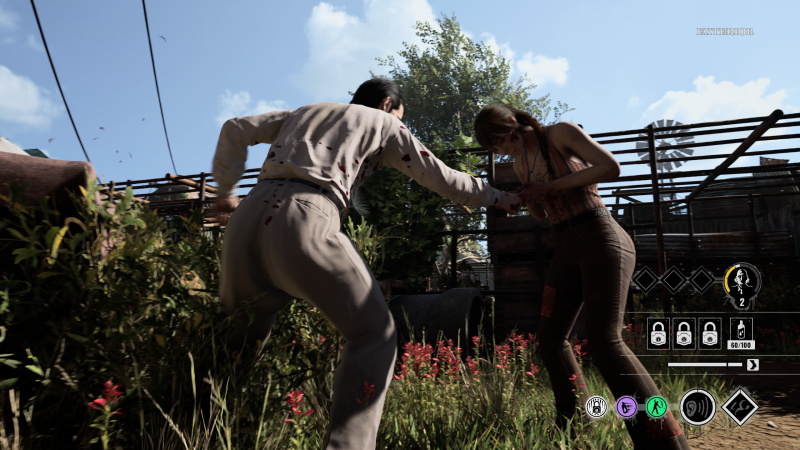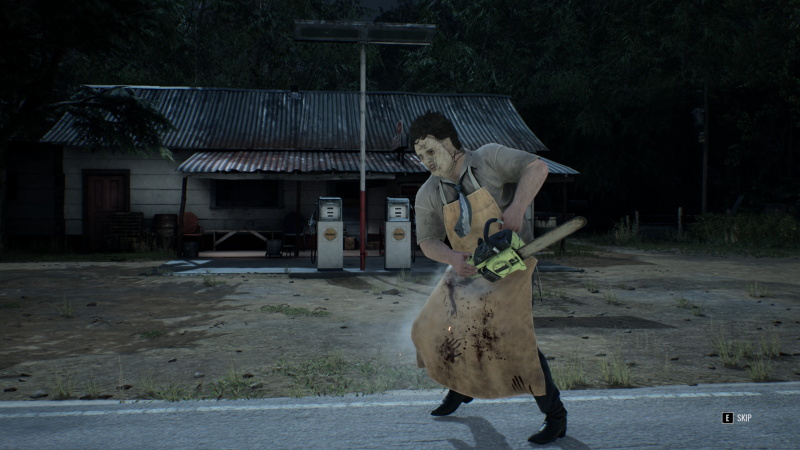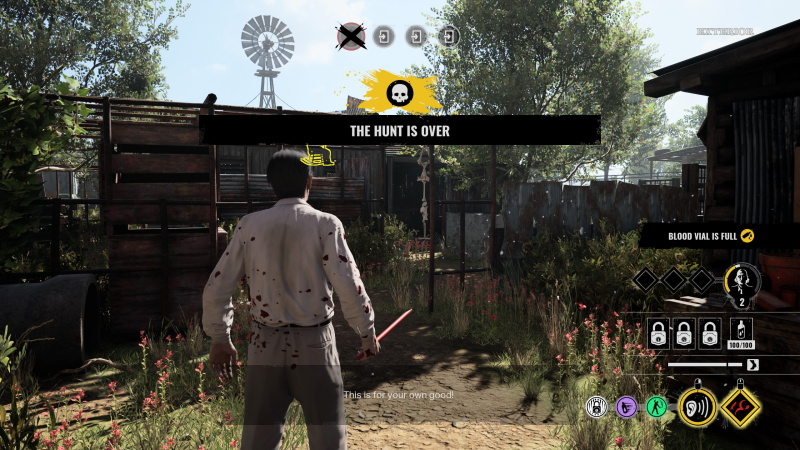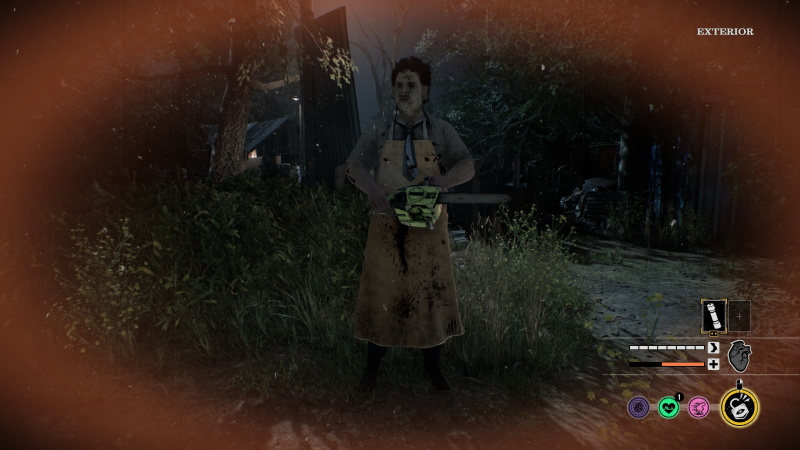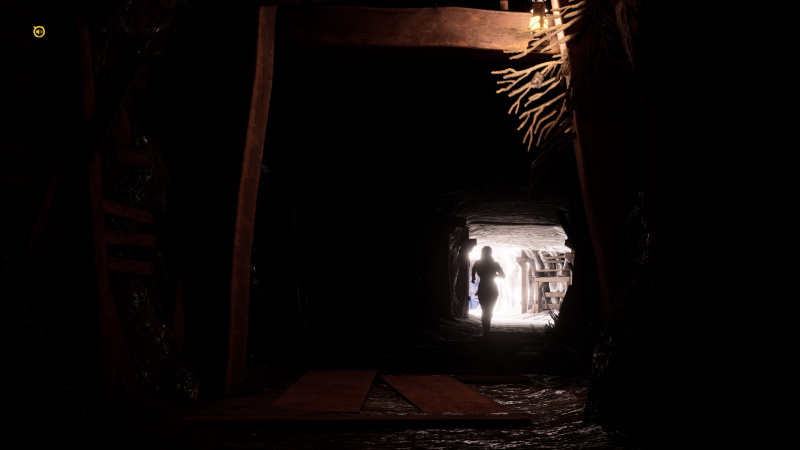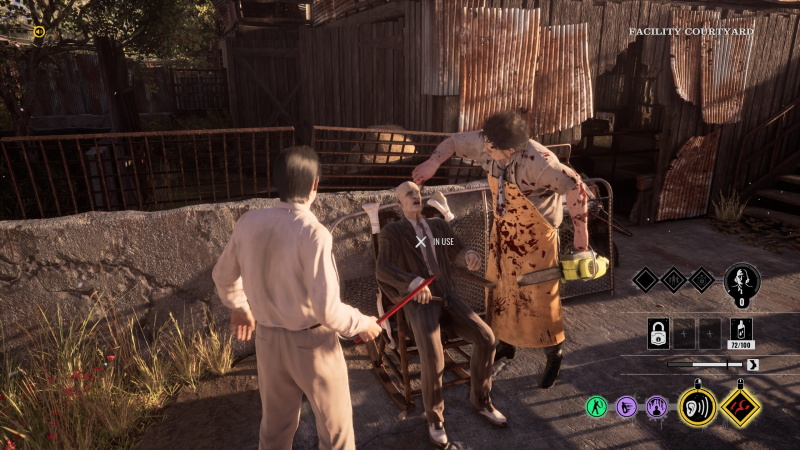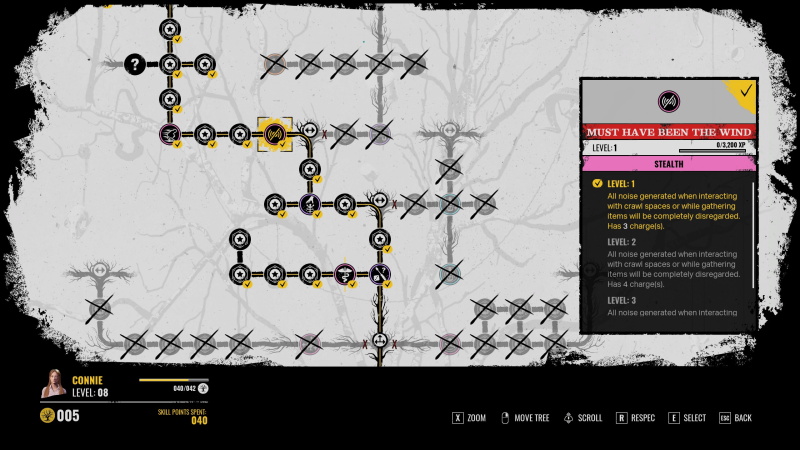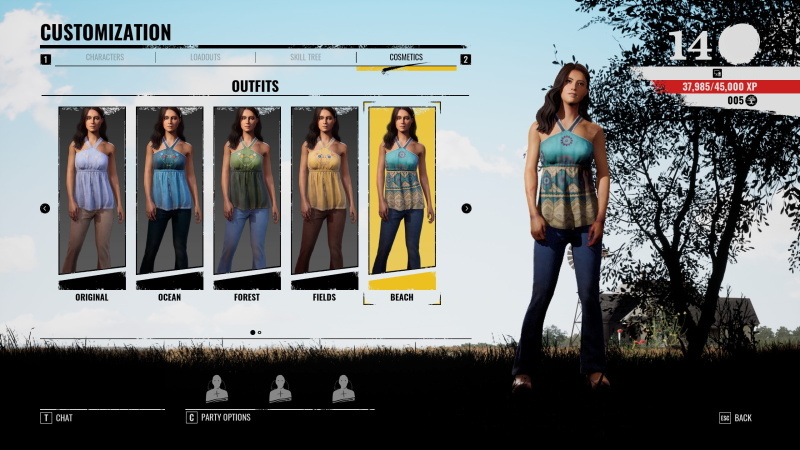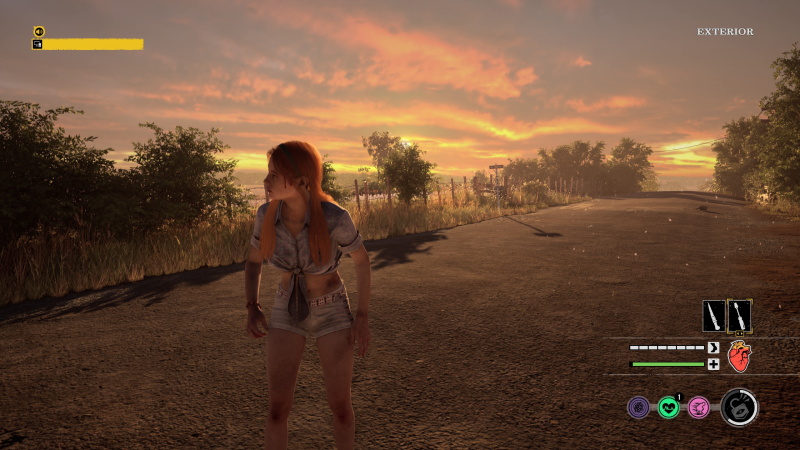1974’s The Texas Chain Saw Massacre opens with the sound of a flashbulb; an iconic, gnawing screech that first illuminates its villains’ terrible crimes. It’s a moment that thrusts Texas Chain Saw’s world of stifling heat and rotting flesh directly into viewers’ faces, forcing them to confront the horror contained within. However, 2023’s The Texas Chain Saw Massacre – an asymmetrical horror game from Sumo Nottingham and GUN Interactive based on that seminal piece of slasher fiction – aims not only to make you face the horror but to play an active part in it.
This new game aims to re-create the experience of the film world by pitting players against each other, either as the Victims or the antagonistic Family, in a battle of wits and cunning to see who can survive and what will be left of them. To assess what the game has to offer, we’ll be tackling various sections based on the many aspects and mechanics to give a more comprehensive idea of what TCM is all about, starting with the first things you’ll see after booting up the game.
Onboarding and Matchmaking
These two ‘problem’ areas constitute the vast majority of the criticisms we have with The Texas Chain Saw Massacre. Though we’re confident that Sumo and GUN will go in and address many of these issues as time goes by, as other games in this genre have, we’re reviewing the game that launches Friday and that game has some fundamental issues.
First and foremost, the game’s tutorial system is extremely underwhelming. TCM comes packed with a long list of tutorial videos, of which two take center stage; one focusing on Victim gameplay and one focusing on Family gameplay. These are the only voiced videos of the lot, and they leave out a good chunk of important information that would greatly benefit the players’ game knowledge. For instance, the Victim video fails to mention that road exits can be blocked by cattle grids, nor how to disable them.
You can find this info deeper into the game’s selection of tutorial videos, but at over an hour to watch all of these and with no ability to seek, it’s doubtful that most players will go through them all. We witnessed the consequence of this ourselves in matches, with many players finding themselves confused by several of the game’s intricacies. Some mechanics, such as the Family Focus ability, aren’t even explained by any of the tutorials. In a game as dense as Texas Chain Saw can be, improvements to the way players are introduced to such concepts would go far in welcoming new players.
Matchmaking also has some odd quirks that often create difficulties when trying to find a good match. Granted, we played TCM during its review period, where very few players had access to the game, making it a challenge to fill lobbies – but it has to be noted that the way the game handles lobbies that can’t fill is particularly painful. Each public lobby has a 3-minute timer that counts down to 0 and if a match doesn’t fill in that time, everyone is kicked back to the main menu. If you’re in an in-game party, it will either be disbanded or glitch out, causing further difficulties. The lobby timer will be extended when new players join, but this often won’t be enough to get a game going when player population is low.
Now, this won’t be an issue at launch, or for some time to come, but we fear if unchanged, it could make filling a lobby difficult down the line; especially with the higher-than-ordinary 7-player requirement. We would also love to see the addition of bots in the future, not only to fill games – which can often feel doomed if there’s an early disconnect – but to provide an outlet for players to learn in private matches.
UI and Accessibility
Texas Chain Saw’s UI is solid for the most part – lots of information is clear and accessible, without the UI cluttering the screen or distracting from the core gameplay. Cooldowns are obvious and easy to track, as are readied abilities. The option to have minimal or no HUD is also welcomed, giving experienced players a greater level of freedom over their UI. Streamers and content creators will appreciate the option to anonymize player names, too. However, one element of the UI that could perhaps be improved are action prompts, which can sometimes be obscured and difficult to trigger, especially due to the hectic nature of the game.
The UI for character customization, load-outs, and skill trees are a bit strange in their placement within the menus, even though they work well and are fairly clear overall. Despite that, most of the time you’ll be using these menus, you’re likely to be in a match lobby with a countdown timer. Trying to rush through customizations so you can update your loadout before the match starts is sometimes cumbersome and stressful. Though these menus are accessible from the Main Menu, going to the Main Menu removes you from matchmaking, and as of the time of this writing, also removes you from your in-game party.
Still, the UI has some other very positive additions, such as showing an official name for each map area you visit, shown in the top-right corner of the screen. This is huge for team communication and strategy and spares a little extra time or effort for players having to more deeply learn maps to create arbitrary names for each area themselves.
What would help is a broader suite of accessibility options, since right now, the only things that could really be classified as such are the options to enable subtitles and disable vibration. This list is extremely lean, and more options here would open the game up to a larger number of players.
General Game Flow
In a general sense, the core gameplay of TCM is exciting, fun, and rewarding, with most matches managing to feel intense, collaborative, and even hilarious; as long as you have a decent team and communication.
Randomization of items and a total of four exit locations per map provides a good amount of variance and dynamics to each match, keeping things relatively fresh, even if some elements tend to feel similar between rounds.
The game balance feels rather good overall, with only a few small caveats, especially regarding the quality of teamwork and communication. On the subject of communication, the in-game voice chat works quite well, as long as people are actually using it, which tends to be one of the biggest variables in the quality of an asymmetrical online multiplayer experience. It’s unfortunately something that each player can’t do much about as an individual, aside from finding a solid (and relatively large) group of reliable friends to play with, which also has its own caveats. It can be difficult to keep that many friends engaged with the same game for a while, but if you can, Texas is likely to be an unparalleled blast.
When teammates aren’t on voice chat, matches can become difficult and disorganized, not knowing teammates’ current whereabouts or accomplishments. Some additional mechanics or options surrounding this could go a long way, along the lines of having more in-game communication options, such as emotes or marking areas or items. It’d also be a huge help if Victims had any kind of temporary visual ability to see current locations through walls, or a faint trail left behind by your teammates to have an idea of where they’ve been.
Some Victim matches feel slightly in favor of the Family side, though there’s often a delicate balance to even things out that comes into play. We’d imagine the devs have already thought through and tested this out, but some matches really feel like one extra victim on the team could have swayed things in a more fair manner. That being said, there will always be an inherent imbalance with a genre such as this, however small, and player skill and familiarity with the game will also impact individual match balance.
Playing as Victims
Playing as a Victim in TCM is somewhat of a polarizing experience since there are so many factors that can go wrong and completely ruin a match, with a good amount of them being out of your control. However, when the odds fall in your favor, playing Victim can be a gratifying, thrilling time.
The stealth mechanics present when playing as a Victim provide some unique advantages over the Family in some ways and are fun to use, especially since the game’s stealth mechanics play on your own fear of being caught. This frequently results in high-stakes scenarios where you have to manage your own gut response and pick the right time to run. This is a great adaptation of the source material being brought into gameplay form and helps you empathize with the position of poor Sally Hardesty. You often feel like a deer in headlights.
Victims also have a variety of ways to fight back or to escape on top of their stealth abilities, giving a good dose of variety and depth to the gameplay. Still, when playing as a Victim, matches can often and quickly snowball out of your control, as other players die early, disconnect, or fail to communicate and work towards objectives. Regardless of many of these factors, there still tends to be a small glimmer of hope on your side, and matches rarely ever feel totally unsalvageable. The balancing options and advantages the Victims have at their disposal come to the rescue at just the right moment sometimes, and finding that one item you’ve been searching for can be just the thing that turns the tide of the match.
On the negative side of playing Victim, we have a small handful of complaints, starting with the lack of visual options or clarity available. When playing as a Victim, you’re often stuck in places that are dark, disorienting, and confusing, with barely any options to find your way and very few light sources to speak of. While the Family side has the Focus ability that highlights your fellow teammates and a few key objective markers around the map for a short time, the Victims are left with no such thing, literally poking around in the dark for a good amount of time during most matches.
This confusion, as well as the absence of any type of flashlight or ability to find your way around, was certainly intentional from the developer’s standpoint, but the extreme nature of how much of a disadvantage this can cause feels a tad overkill at times. These factors can also lead to many early deaths, which stifles progression in the game as a whole, making it harder to learn maps, layouts, or strategies for playing Victim.
Though Ross Tregenza’s soundtrack for the game is, on the whole, strong – the main menu theme is a haunting highlight – when compared to GUN’s last asymmetrical title (the incomparable Friday the 13th: The Game,) there’s a noticeable lack of foreboding or startling music cues to go alongside the roving killers and their actions, reducing the fear-factor slightly. Arguably, the relative ambiance and silence in the game’s sound design does lend itself to the tone of the original TCM film a little bit more and allows your mind to play tricks on itself, but it doesn’t invoke the constant nerve-wracking tension that Friday was often able to accomplish.
Playing as Family
Playing as the Family is a starkly different experience from playing as a Victim. As the name would imply, whilst teamwork can be the key to success as Victim, it is even more vital as the Family.
Collaborating with the other killers to trap or kill a Victim is very rewarding, and since tracking and killing Victims isn’t nearly as easy as you might think, teamwork is typically required to truly ensure someone’s demise. Going it solo as a killer will often end up with losing track or getting cut off the trail of your chosen Victim over and over again until you call upon your fellow hunters to join the cause.
All of the 5 different Family members available at launch feel very distinct from each other and all come with their own pros and cons, with none of them clearly outshining the others. A good balance was struck in creating them, which is not always the case for asymmetrical games and it’s very appreciated here.
The Family’s gameplay is a brilliant translation of the film world and really hones into what makes The Slaughter Family unique among other horror villains. In a world where Texas Chain Saw as a franchise within pop culture is often reduced down to just being Leatherface, the spotlight placed on the Family as a unit feels essential in capturing the terror that The Texas Chain Saw Massacre inflicted upon the psyche of a generation.
One of the only major down-sides about playing the Family is that sometimes, due to a variety of factors, matches can feel a little aimless. Sometimes Victims simply aren’t proactive enough, which leaves you with fewer and fewer options if Victims want to camp in a quiet corner or happen to be AFK. Eventually, leveling up Grandpa to his maximum tier (which reveals all survivors on a cooldown) or waiting for Victim’s condition to wear out become your only reliable option if a match drags on too long with Victim players who aren’t engaging.
Progression and Customisation
The Texas Chain Saw Massacre features a swath of progression and customization options, giving players plenty of goals to aim for in building their characters and lots of choices to make whilst doing so. The game’s progression essentially revolves around skill trees, with each character having a unique tree that provides its own selection of perks.
There is some overlap here, with some perks appearing on multiple trees, but the Random Perk function – which allows you to unlock perks not found on your character’s tree – and various branching paths within each tree means each player’s experience leveling a character will be distinct, whilst never prohibiting you from getting desired perks. Attribute points are the other main feature of skill trees, letting you increase your character’s base stats in thought-provoking ways. Do you cover your character’s weaknesses to make them a solid all-rounder or amplify their strengths to maximize their utility as a member of a team?
Sumo and GUN have made an array of smart choices that really solidify this system as a fantastic example of asymmetrical horror progression done right. Perhaps the smartest of these is the ability to re-spec your characters’ skill trees at any time, not only allowing players to make new decisions for their characters but move their points onto another character entirely. This provides a lot of freedom for players and keeps the game frequently feeling fresh.
Ability trees, which level up your character’s individual power, can also be reset without also needing to reset your skill tree, which is a nice bonus. You never feel ‘locked in’ to playing one specific role or side even. Progression is also remarkably well-paced, never feeling too quick without dragging out and getting grindy. It’ll give players plenty to chew on, especially as new characters are (presumably) added to the game in the coming months, without taking an absurdly long time to reach an even playing field.
The complaints about the progression system are few but include the feeling that there’s a bit of a gulf between fully-leveled and level-0 characters. The former is extremely strong when spec’d right and, whilst it doesn’t take too long to reach level 10 with one character, we worry it may be off-putting to new players when enough time has passed that the majority of the player base is level 10. The other complaint is that the customization system choices become completely erased from a character when you switch to playing as another character and re-spec, where it seems fairly logical to have a separate spec and progression choice saved per character instead of being an ever-revolving pool of points that you need to re-manage and re-distribute every few matches.
Amount of Content/Value/Variety
Texas Chain Saw’s incredibly fun core gameplay will be enough to keep a lot of players coming back – its spiritual predecessor, Friday the 13th: The Game, got one of our reviewers around 100 hours of gameplay out of this strength of its core loop alone, and we suspect that TCM will eke just as much play-time out of those who fall in love with its central charms.
Still, a wide variety of content will inevitably give greater longevity to a game like this, and TCM, at launch, mostly meets this bar. With 5 characters on each side, there’s a decent selection to choose from and all bear their own quirks that separate them from each other, Family members especially. Victims’ Star Sign abilities and Family members’ abilities shake up each match and are a great bolster that aligns with the game’s focus on teamwork. The new characters – all of the victims and Family members Johnny and Sissy – fit the world of Texas Chain Saw well, seamlessly blending in with the original trio whilst also expanding that world with interesting lore additions. This is all great stuff, and we trust that future additions will further this trend of creating faithful and exciting new characters.
However, for those looking for the type of extrinsic rewards many live-service games offer (e.g. battle-passes, cosmetic rewards, and quests,) know that Texas Chain Saw isn’t aiming to provide that kind of motivation. Beyond the love of the game itself, and the character progression described earlier in this review, there isn’t much to actually earn in The Texas Chain Saw Massacre.
Victims and Leatherface do have some unlockable outfits that are achieved after playing a few matches as each, but these are limited and earned rather quickly. Other family members notably do not have any cosmetic options, beyond a range of extra kills which are mostly paid DLC content. There’s also a selection of Behind the Scenes stills from the production of the original film, as well as concept art for the game, which sets out some lengthier goals for those who are interested.
This is very similar to how Friday the 13th worked and will be a welcome change for many that feel inundated in an age where nearly every multiplayer game feels like a second job. That being said, for those who depend on those kinds of systems to keep playing long-term (or have friends who do,) The Texas Chain Saw Massacre will leave you wanting.
Technical Performance (Controls/Audio/Visuals/Bugs)
TCM is a gorgeous game, one that captures the saturated, swelteringly hot look of the 1974 film in great detail. Characters and environments feel accurate to their ‘74 appearances, with lots of loving touches selling the authenticity whilst also paying homage to these iconic locations and killers. On our review machines, an RTX 3070/Ryzen 5 5600x combo and an RTX 3080/i7 9700k combo, the game ran very well for the most part, only suffering from a few minor frame-drops in particularly intense gameplay scenarios.
The game’s voice acting is effective across the board. Everyone here puts in committed performances that communicate their character and situation brilliantly. Edwin Neal, the actor who originally played the Hitchhiker in the original film, returns as the character here, delivering the same delirious energy he gave to the Hitchhiker back in 1974.
He’s a delight, as are Rob Zombie’s Halloween alums Scout Taylor-Compton and Kristina Klebe, playing Victim Julie and Family member Sissy respectively. Their casting feels like a shining nod to the enormous influence The Texas Chain Saw Massacre has had as a franchise, with Zombie’s films, in particular, being heavily inspired by the series. Klebe particularly is infectious as the killer, lending the character’s Manson family-inspired singing a chilling inflection.
Compton and Klebe, alongside Jason Voorhees actor, Kane Hodder, and a range of other talented actors performed mocap for the game. These performances add significant impact to gameplay scenarios and general immersion, with Hodder’s kills as Leatherface especially standing out. His mocap performance is weighty, feeling distinct yet true to the essence of the character over the years. It is a treat to see this legendary slasher actor take on such a role, putting his own spin on things.
The game does feature a few bugs, notably involving the in-game voice chat which would consistently break when matches failed to fill, forcing a restart to fix the issue. GUN has been made aware of this particular problem, though and we hope that any more found from here on will also be resolved in due time. TCM is, overall, very technically sound, especially for a game with this many moving parts. It is a real feat.
Conclusion
In conclusion, then, The Texas Chain Saw Massacre is a lively, refreshing addition to the asymmetrical horror space. It shakes up a lot of the conventions of the genre, with its emphasis on teamwork leading to many memorable interactions within the review period alone. It’s a varied, enjoyable, and mechanically rich experience that ought to serve as a fantastic pace-breaker from the endless ‘heavier’ multiplayer games out there. Though Texas Chain Saw could do more to effectively show new players the ropes and the matchmaking issues that exist currently could impact the game as the player base inevitably dwindles over the years, the game, at release, is both a worthy follow-up to Friday the 13th The Game and an incredibly engaging asymmetrical title in its own right; one which we will be returning to for years to come.
 (8.5 / 10)
(8.5 / 10)
Great
 (8.5 / 10)
(8.5 / 10)Rely on Horror Review Score Guide
Review by Steve Summers and Katy Hanson. Steam review codes provided by the publisher.


